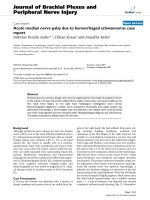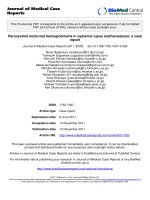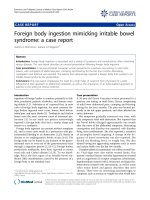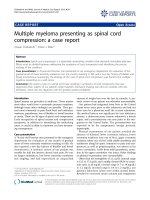Báo cáo y học: "Agranulocytosis and hepatic toxicity with ticlopidine therapy: a case report" ppt
Bạn đang xem bản rút gọn của tài liệu. Xem và tải ngay bản đầy đủ của tài liệu tại đây (258.15 KB, 3 trang )
CAS E RE P O R T Open Access
Agranulocytosis and hepatic toxicity with
ticlopidine therapy: a case report
Antonino M Previtera
1*
, Rossella Pagani
2
Abstract
Introduction: Ticlopidine is a plat elet inhibitor used to prevent thrombosis in patients with cerebrovascular or
coronary artery disease. The most common side effects are mild and transitory: diarrhea, dyspepsia, nausea and
rashes. More serious, but less frequent, adverse effects are hematological dyscrasia and cholestatic hep atitis. We
report a rare case of agranulocytosis associated with hepatic toxicity, probably related to the use of ticlopidine.
Case presentation: A 70-year-old Caucasian woman, with no previous history of hematological or liver diseases,
was treated with ticlopidine 250 mg twice daily immediately after a vertebrobasilar stroke. Upon admission, her
blood tests were normal. About four weeks later she developed agranulocytosis and hepatic toxicity. Ticlopidine
was discontinued immediately, and aspirin 25 mg and dipyridamole 200 mg were given twice daily. She was
treated with hematopoietic growth factors (granulocyte colony stimulating factor), with a rapidly increased white
blood count and progressive normalization of liver tests as a result.
Conclusion: In the first three months following initiation of ticlopidine therapy, regular monitoring of complete
blood cell count and of liver function tests is essential for the early detection of serious and unpredictable side
effects.
Introduction
Ticlopidine is a thienopyridine derivative with platelet
inhibitor capability. It acts by inhibiting the platelet
aggregation induced by adenosine d iphosphate and by
blocking the membrane receptors of fibrinogen. It is
used to prevent thrombosis in patients with cerebrovas-
cular or coronary artery disease. Two randomized clini-
cal studies [1,2] proved the drug’ s efficacy versus
placebo [1] and aspirin [2] in reducing the risk of transi-
ent ischemic attack and stroke in patients with a history
of cerebrovascular events. Because of its adverse effects,
the use of this drug is reserved for patients in whom
aspirin is contraindicated, not tolerated, or when treat-
ment with aspirin fails.
The most common side effects are mild and transitory:
diarrhea, dyspepsia, nausea and rashes. More serious, but
less frequent, adverse effects are hematological dyscrasia
(particularly agranulocytosis, aplastic anemia, neutro-
penia, pancytopenia, thrombocytopenia and thrombotic
thrombocytopenia purpura) and cholestatic hepatitis.
However,toourknowledge,thereareonlyafewpub-
lished reports of the simultaneous occurrence of hemato-
logical and hepatic toxicity induced by ticlopidine. We
report a case of agranulocytosis associated with chole-
static hepatitis related to the use of ticlopidine.
Case presentation
A 70-year-old Caucasian woman was admitted to our
Rehabilitation Ward (San Paolo Hospital, Milan)
because of gait ataxia after right bulbar stroke, which
occurred 10 days previously. Her medical history
pointed out hypertension and hypercholesterolemia. She
had no prior history with regard to hematological or
liver diseases, alcohol abus e or blood transfusion. Her
habitual medications we re aspirin 100 mg/day, atorvas-
tatin 20 mg/day and amlodipine 5 mg/day. Immediately
after her stroke, she discontinued aspirin and started
therapy with ticlopidine 250 mg twice daily.
Upon admission, her blood tests were normal. About
four weeks later, she developed agranulocytosis. Her white
blood count was 2600 cells/μL (reference range: 4000
to 10,000 cells/μL), neutrophil count was 100 cells/μL
* Correspondence:
1
University of Milan, Department of Medicine, Surgery and Dentistry,
Rehabilitation Unit, San Paolo Hospital, Milan, Italy
Full list of author information is available at the end of the article
Previtera and Pagani Journal of Medical Case Reports 2010, 4:269
/>JOURNAL OF MEDICAL
CASE REPORTS
© 2010 Previtera and Pagani; licensee BioMed Central Ltd. This i s an Open Access article distributed under the terms of the Creative
Commons Attribution License ( es/by/2.0), which permits unrestricted use, distribution , and
reproduction in any medium, provided the original work is properly cited.
(reference range: 2000 to 7000 cells/μL), and liver function
tests revealed a mixed cholestasis and hepatocellular
injury. She had no fever and she was asymptomatic. She
had elevated levels of alanine aminotransferase (560 U/L,
reference range 5 to 41 U/L), of aspartate aminotransfer-
ase (551 U/L, reference range 5 to 41 U/L), of g-glutamyl
transpeptidase (449 U/L, reference range 11 to 50 U/L),
of alkaline phosphatase (821 U/L, reference range 98 to
279 U/L). Total and direct bilirubin and the coagulation
tests were normal.
Serology tests for hepatitis A, B and C, and for
Epstein-Barr virus (EBV) and cytomegalovirus (CMV)
were negative. The anti-nuc lear antibodies (ANA), the
anti-mitochondrial antibodies (AMA) and anti-smooth
muscle antibodies (LKM) were all negative. Cobalamin
and folate dosages were normal.
An abdominal ultrasound scan showed liver steatosis
but did not highlight any alterations in the intra-hepatic
and extra-hepati c biliary pathways and, in parti cular, no
sign of dilatation emerged. A bone marrow aspirate
showed myeloid maturation arrest, with decreased mye-
loid precursors and immature forms, like by iatrogenic
attack. A cytogenetic analysis on bone marrow blood
was 46, XX.
Ticlopidine was immediately discontinued. Aspirin 25
mg and dipyridamole 200 mg twice daily were started
[3]. She was treated with granulocyte colony stimulating
factor (Filgastrim, 0.3 mg/day) with an excellent evolu-
tion. On the second day, her white blood count was
normal (white blood cells: 5300 cells/μL; neutrophil
count 1500 c ells/μL); her liver function tests progres-
sively got better with normalization after four weeks. A
liver biopsy was not performed because of her serious
hemathological dyscrasia and the self-limiting nature o f
liver disorder.
The pathogenesis of the various types of toxic effects
associated w ith ticlopidine therapy is unclear. T here is
no test available that can confirm the diagnostic hypoth-
esis of the drug t oxicity apart from the exclusion of
other possible causes and the normalization of the
blood tests after the drug discontinuation.
In our patient, ticlopidine may have b een responsible
of concomitant hematological and hepatic toxicity. In
fact, other diagnostic hypothesises were excluded and
when the drug was discontinued, the blood cell count
and the liver function tests rapidly normalized.
The onset of hematolo gical dyscrasia is temporally
related to the initiation of ticlopidine therapy, generally
occurring within the first three months , and the dyscra-
sia res olves within three weeks after discontinuation of
therapy [4].
The latent period between the introduction of ticlopi-
dine and the appearance of hep atotoxicity is variab le,
ranging from one week t o six months, but it is i n the
range of two to 12 weeks in most patients [5]. Hepatic
toxicity is not dose depende nt [6] and is not related to
the t reatment duration [7]. When ticlo pidine is discon-
tinued, symptoms and liver abnormalities usually resolve
within one to three months. In the cases of drug-
induced hepatotoxicity, the liver biopsy can suggest but
not establish the diagnosis, and is mainly directed to
exclude other diagnosis.
While severe neutropenia is a life-threatening adverse
effect due to the occurrence of fatal infections, there are
no fatal cases and no irreversible hepatic damages. The
only reported fatal case was due to the co-occurrence of
neutropenia, which led to septic shock [8].
We emphasize that, in the first three months following
initiation of ticlopidine therapy, besides a complete
blood cell count, periodic checks of liver function are
recommend ed. Hepatic toxicity induced by ticlopidine is
underestimated. Regular monitoring of complete blood
cell count and of liver function tests is important for
prompt detection and treatment of adverse reactions
but is unlikely to prevent their occurrence altogether.
Conclusions
In the first three months after starting ticlopidine t her-
apy, regular monitoring of complete blood cell counts
and of liver function tests should be recommended for
the early detection of serious side effects, even if
infrequent.
Competing interests
The authors declare that they have no competing interests.
Authors’ contributions
AMP designed the study, treated our patient, drafted the manuscript, and
contributed to the data collection. RP helped to design the study, treated
our patient, contributed to manuscript drafts, and contributed to the data
collection. All authors have read and approved the final version of the
manuscript.
Consent
Written informed consent was obtained from the patient for publication of
this case report and any accompanying images. A copy of the written
consent is available for review by the Editor-in-Chief of this journal.
Acknowledgements
We wish to thank Dr Giuseppina Frigo who helped with data collection.
Author details
1
University of Milan, Department of Medicine, Surgery and Dentistry,
Rehabilitation Unit, San Paolo Hospital, Milan, Italy.
2
Rehabilitation Unit, San
Paolo Hospital, Milan, Italy.
Received: 26 January 2010 Accepted: 12 August 2010
Published: 12 August 2010
References
1. Gent M, Blakely JA, Easton JD, Ellis DJ, Hachinski VC, Harbison JW, Panak E,
Roberts RS, Sicurella J, Turpie AG: The Canadian American Ticlopidine
Study (CATS) in the thromboembolic stroke. Lancet 1989, 1:1215-1220.
2. Hass WK, Easton JD, Adams HP Jr, Pryse-Phillips W, Molony BA, Anderson S,
Kamm B: A randomized trial comparing ticlopidine hydrochloride with
Previtera and Pagani Journal of Medical Case Reports 2010, 4:269
/>Page 2 of 3
aspirin for the prevention of stroke in high-risk patients. Ticlopidine
Aspirin Stroke Study Group. N Engl J Med 1989, 321:501-507.
3. SPREAD Stroke Prevention And Educational Awerness Diffusion -
V Edizione 2007 - Ictus cerebrale: linee guida italiane di prevenzione
e trattamento, 319. .
4. Paradiso-Hardy F, Angelo MC, Lanctot KL, Cohen EA: Hematologic
dyscrasia associated with ticlopidine therapy: evidence for casuality.
CMAJ 2000, 163:1441-1448.
5. Grieco A, Vecchio FM, Greco AV, Gasbarrini G: Cholestatic hepatitis due to
ticlopidine: clinical and histological recovery after drug withdrawal. Case
report and review of the literature. Eur J Gastroenterol Hepatol 1998,
10:713-715.
6. Alberti L, Alberti-Flor JJ: Ticlopidine-induced cholestatic hepatitis
successfully treated with corticosteroids (letter). Am J Gastroenterol 2002,
97:107.
7. Kubin Cj, Shermann O, Hussain KB, Feinman L: Delayed onset ticlopidine
induced cholestatic jaundice. Pharmacotherapy 1999, 18:1006-1010.
8. Celyan C, Kirimli O, Akarsu M, Under B, Guneri S: Early ticlopidine-induced
hepatic dysfunction, dermatitis and irreversible aplastic anemia after
coronary artery stenting. Am J Hematol 1998, 59:260-264.
doi:10.1186/1752-1947-4-269
Cite this article as: Previtera and Pagani: Agranulocytosis and hepatic
toxicity with ticlopidine therapy: a case report. Journal of Medical Case
Reports 2010 4:269.
Submit your next manuscript to BioMed Central
and take full advantage of:
• Convenient online submission
• Thorough peer review
• No space constraints or color figure charges
• Immediate publication on acceptance
• Inclusion in PubMed, CAS, Scopus and Google Scholar
• Research which is freely available for redistribution
Submit your manuscript at
www.biomedcentral.com/submit
Previtera and Pagani Journal of Medical Case Reports 2010, 4:269
/>Page 3 of 3









